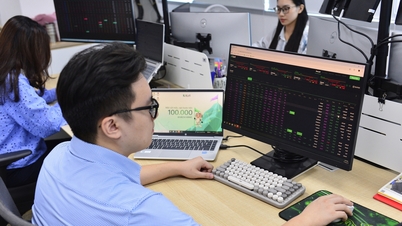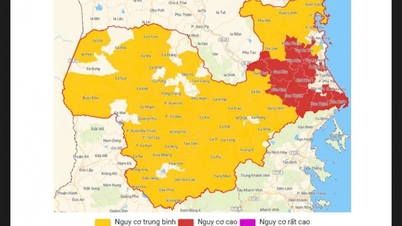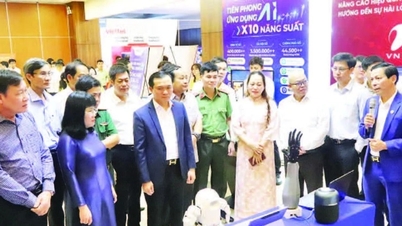“Investor Conference 2025” was held on October 28, 2025 in Ho Chi Minh City with the theme “Vietnam 2.0” - a new development phase shaped by extensive reforms and the Government 's long-term vision, aiming to make Vietnam a developed country by 2045.
Mr. Jens Lottner, General Director of Techcombank - representing the Banking sector - shared with nearly 150 investors around the world about the industry's growth prospects, emphasizing the bank's determination to work with the Government to promote innovation, making long-term contributions to the development of the Vietnamese economy, thereby attracting more quality capital flows from international sources.

Techcombank (HOSE: TCB) is known as a bank with a comprehensive financial ecosystem. Currently, the bank is leading in terms of capitalization among listed private commercial banks; leading the industry in terms of CASA ratio, operating efficiency and asset quality, with a capital adequacy ratio (CAR) of 15.8% and a bad debt ratio among the lowest in the market.
During the panel discussion at the event, Mr. Jens shared about Techcombank's development strategy, the pillars that create sustainable competitive advantages, as well as growth prospects in the context of Vietnam entering a strong transformation cycle.
Three pillars: Digitalization, Data and Talent
- After more than 5 years with the bank, what do you think is the key factor to Techcombank's success?
The first core factor is people. Techcombank has built and possesses a high-quality human resource team, combining domestic and international talents. In addition to domestic recruitment, we also continuously recruit international personnel and attract Vietnamese people studying and working in Silicon Valley, Los Angeles, Singapore, Sydney, Paris, London... to return to the country. In parallel with a comprehensive training and development roadmap, Techcombank has become a place that gathers many talents with an average income per employee of Techcombank about 50% higher than that of other banks, along with many attractive benefits and policies. For Techcombank, talent is the foundation to promote the remaining two pillars: digitalization and data.

Regarding digitalization, Techcombank invests heavily in technology and prioritizes pursuing a cloud-first strategy. Currently, 60% of the bank's technology infrastructure has been moved to the "cloud", much higher than the 20% of other large banks. Thanks to that, Techcombank can expand its scale without increasing its operational staff, helping the number of customers increase 2.5 times in the past 5 years with optimal marginal costs.
In terms of data, with over 8 billion customer data points processed every day thanks to its position as one of the banks with the largest transaction volume, Techcombank builds a detailed profile for each customer with about 12,000 characteristics. This data is used in CRM and digital marketing models, helping to improve customer experience and optimize business efficiency.

- As a leading bank in terms of efficiency, Techcombank's cost-to-income ratio (CIR) is currently the lowest in the industry (about 30%). So is there still room for improvement, sir?
Currently, 40% of Techcombank’s revenue comes from digital channels, with operating costs 10-15 percentage points lower than the current CIR. In theory, we could reduce costs further, but Techcombank still prioritizes investment. Over the next 5 years, the bank plans to spend more than 1 billion USD on technology, marketing and improving employee income. We are confident that we can continue to invest while maintaining CIR at 30%, even when margins are under pressure, to ensure sustainable growth.
Competitive advantage that is difficult to copy
- It is known that Techcombank is equally strong in both retail and corporate sectors, which is rare in Vietnamese banks. Can you share the bank's long-term vision for these business sectors?
Techcombank will serve Vietnam’s rapidly growing middle class. Currently, its loan portfolio is 55-60% corporate and 40-45% retail, but in the next five years, this ratio will reverse, with retail dominating. When GDP per capita reaches 6,000-7,000 USD, the demand for asset accumulation and personal consumer loans will increase sharply, creating a great driving force for the retail segment.
- Many people think that Techcombank depends heavily on real estate. Will this change in the future, sir?
Excluding mortgage loans, real estate accounts for about 1/3 of Techcombank’s loan portfolio. This proportion will decrease to about 20-25% according to the bank’s credit portfolio diversification strategy. Up to now, we have only financed high-end projects in Hanoi and Ho Chi Minh City, but the land fund in these areas is almost exhausted. Instead, Techcombank will shift to the infrastructure sector, while promoting unsecured loans and retail products to maintain net interest margin (NIM).

- How does Techcombank maintain its advantage in a competitive market?
Techcombank builds its advantage on three key factors. First, low-cost funding with an industry-leading CASA ratio helps reduce the cost of capital. Second, Techcombank has the highest market share in transactions on the Napas system, consolidating its role as a leading transaction bank. Third, strict risk management helps keep the bad debt ratio low.
For example, in the real estate sector, the bad debt ratio in Techcombank's credit structure over the past 10 years is 0%. The reason is that Techcombank does not provide capital to investors but finances the project through an optimal risk control model. The only thing that needs to be ensured is that the project is completed on schedule and delivered according to customer requirements. This is a model that many parties currently want to implement but have not been able to do.
In addition, corporate culture and investment in three strategic pillars are also difficult factors to copy. For example, while many banks let branch managers have full decision-making authority, Techcombank centralizes data and analysis from headquarters, ensures consistency and efficiency, and then makes recommendations to branches. Investing 500 million USD in technology is difficult, creating a culture of compliance within the organization is even more difficult. These are huge advantages of Techcombank.

Sustainable growth and opportunities from capital markets
- How does Techcombank plan to increase credit growth in the next 2-3 years?
Assuming GDP growth of 8% and inflation of 3-4%, nominal GDP is 12%. With a credit multiplier of 1.5, industry-wide credit growth could reach 18%. Techcombank targets credit growth of over 20%, higher than average thanks to its retail-focused strategy and risk control.
- Apart from credit growth, what are the key drivers supporting net interest income (NII) and fee income (NFI) growth in the coming time?
If credit grows by 20%, NII increases accordingly. NIM may come under some pressure, but the bank can run a good portfolio in this market with NIM above 4%.
In addition, fee income (NFI) is also a very important part, currently contributing 22% to the bank's total operating income, much higher than the industry average (below 10%).
The driver for this growth is that we built our investment banking business early on. The bank now operates a number of fee-based products, so there is plenty of room for fee income to grow.
In the future, the bank will continue to develop the “originate to distribute” model in the bond market, taking advantage of opportunities from the development of the capital market while contributing to promoting economic growth.
- You mentioned unsecured loans, can you tell us what the current proportion of unsecured loans is and how it will change?
Currently, unsecured loans account for 3% of the portfolio, but may increase to 11-12% in the near future. Our technological advantage has helped us accelerate the application of credit assessment models based on alternative methods or data instead of relying solely on the traditional way. Thanks to that, Techcombank has reached the group of business households, and Vietnam has up to 6.5 million business households nationwide. Techcombank is serving 2.5 million business households, 700,000 of which are eligible for loans based on transaction data. This is one of Techcombank's strategic directions to diversify its portfolio and grow sustainably.
In addition, financial investment products in the Vietnamese market still have a lot of growth potential, especially in diversifying products and services. That is also the reason why Techcombank participates in the insurance and digital asset sector with the goal of creating a comprehensive financial ecosystem, not only helping customers manage their finances but also developing sustainable assets and accumulating effectively.
(Source: Techcombank)
Source: https://vietnamnet.vn/techcombank-thuc-hien-chuyen-doi-so-toan-dien-khai-thac-du-lieu-hieu-qua-2459912.html





![[Photo] Prime Minister Pham Minh Chinh receives the delegation of the Semiconductor Manufacturing International (SEMI)](https://vphoto.vietnam.vn/thumb/1200x675/vietnam/resource/IMAGE/2025/11/06/1762434628831_dsc-0219-jpg.webp)

![[Photo] Closing of the 14th Conference of the 13th Party Central Committee](https://vphoto.vietnam.vn/thumb/1200x675/vietnam/resource/IMAGE/2025/11/06/1762404919012_a1-bnd-5975-5183-jpg.webp)









































































































Comment (0)